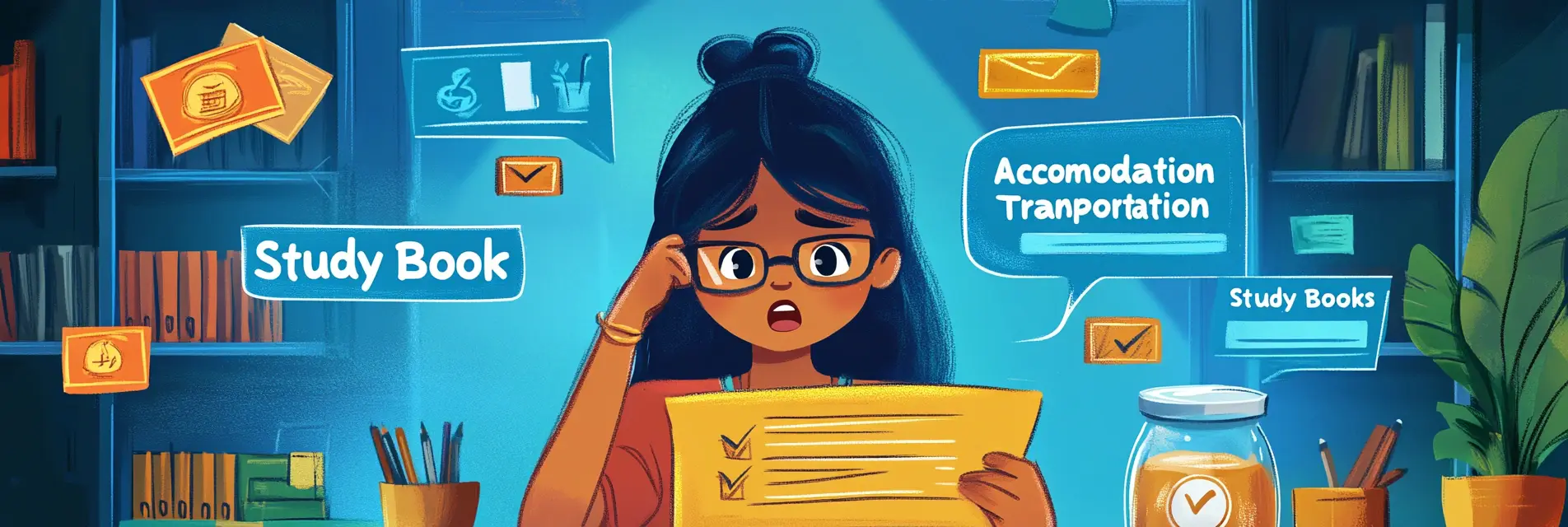
Expenses of the University of Maryland, Baltimore County, USA
Dreaming of studying in the USA, the land of opportunity and world-class universities? Imagine yourself at the University of Maryland, Baltimore County (UMBC), immersed in a vibrant academic environment.
Dreaming of studying in the USA, the land of opportunity and world-class universities? Imagine yourself at the University of Maryland, Baltimore County (UMBC), immersed in a vibrant academic environment. But while the allure of an American education is strong, the costs, including application fees, can seem daunting.
Applying to UMBC typically requires an application fee ranging from $50 to $75, depending on the program. This initial expense can be a hurdle for many international students. But don’t worry! Niyo is here to help you navigate the application process and access potential fee waivers, making your UMBC and American university dreams more attainable.
How to Apply to UMBC
- Check Admission Requirements: Visit the UMBC website and review the specific requirements for your chosen program. This will include GPA requirements, standardized test scores (TOEFL/IELTS, GRE/GMAT), and any prerequisite courses.
- Prepare Application Materials: Gather all necessary documents, including:
- Transcripts from previous institutions
- Standardized test scores
- Letters of recommendation
- Statement of purpose
- Resume/CV
- Complete the Online Application: UMBC uses an online application system. You’ll need to create an account and fill out the application form, providing all required information and uploading your documents.
- Pay the Application Fee: The application fee is typically $50-$75.
- Submit Your Application: Once you’ve completed all sections and paid the fee (or secured a waiver), submit your application.
- Track Your Application Status: You can usually track the status of your application online through the UMBC application portal.
Expenses While Studying at UMBC
While application fee waivers can provide initial savings, it’s essential to understand the overall cost of studying at UMBC. Here’s a breakdown of potential expenses:
- Application Fee: $50 - $75
- Tuition and Fees: This varies greatly depending on your residency status and program.
- Undergraduate: In-state students can expect to pay around $13,257 per year, while out-of-state students will pay approximately $31,225 per year.
- Graduate: Costs vary significantly by program. You can find program-specific tuition information on the UMBC website.
- Living Expenses:
- On-Campus: Around $15,146 per year (includes room and board)
- Off-Campus: Can range from $18,046 to $20,000+ per year depending on your lifestyle and housing choices (includes rent, groceries, utilities, transportation).
- Books and Supplies: $1,600 per year (estimated)
- Health Insurance: $2,000 - $3,000 per year (this is a requirement for all students)
- Miscellaneous Expenses: (This includes entertainment, social activities, and personal needs) - Varies greatly, budget at least $1,000 - $2,000 per year.
Expense Category Details
Here’s a more detailed breakdown of expenses, including pre-departure costs:
| Expense Category | Description | Estimated Cost |
|---|---|---|
| Pre-Departure | ||
| Application Fees | Fees charged by universities to process your application. | $50 - $75 per application |
| Standardized Tests | Exams like TOEFL, IELTS, GRE, GMAT. | $150 - $300 per test |
| Visa Application | Fees for processing your student visa. | $160 - $265 |
| Airfare | Cost of your flight to your study destination. | $1,000 - $2,000+ (depending on origin) |
| Living Expenses | ||
| Books and Supplies | Cost of textbooks, notebooks, and other materials. | $1,600 per year |
| Health Insurance | Medical insurance required by most universities. | $2,000 - $3,000 per year |
| Miscellaneous Expenses | Other personal expenses like entertainment and utilities. | $1,000 - $2,000+ per year |
How Niyo Can Help Save on Expenses:
Niyo: Your Smart Spending Solution for Students
Managing your finances as an international student can be tricky. Niyo offers tools and features that simplify money management and help you save on everyday expenses:
Application Fee Waivers:
We have partnered with multiple U.S. universities, including the University of Maryland, Baltimore County (UMBC), to offer application fee waivers for international students like you. This means you can focus on crafting a stellar application without worrying about the financial burden of application fees. Our team works directly with these universities, simplifying the waiver process and ensuring you meet all the necessary requirements**.**
Ready to Start Saving?
Here’s how to secure an application fee waiver for US universities through Niyo:
- Explore Niyo’s Student Offers Page: Visit the Niyo website and navigate to the Student Offers section. You’ll find a dedicated page with a list of study abroad application fee savings and exclusive international student fee waivers.
- Submit the Request Form: Fill out a quick form with your program preferences, target universities (like UMBC!), and basic information. This helps us match you with eligible waiver options.
- Connect with a Niyo Representative: Once you’ve submitted the form, a Niyo representative will be in touch to confirm your eligibility and guide you through the application process with the waiver in place.
Explore Offers Here: Explore Fee Waivers
Discounts on Essential Exams: Prep for your studies with exclusive discounts on crucial exams:
- GMAT: Save up to $25 (₹2000) on your GMAT exam fee.
- GRE: Enjoy savings of up to ₹4500 on the GRE exam fee.
- TOEFL: Save up to ₹3500 on the TOEFL exam fee.
- PTE: Save up to ₹3000 on the PTE exam fee.
- And More: Keep an eye on the Niyo website for the latest discounts and offers.
Zero Forex Markup**:** Use your Niyo card for international transactions without incurring extra forex charges. This can lead to significant savings, especially when paying for tuition, rent, or other large expenses. Explore Fee Transfers
Easy Budgeting and Tracking: The Niyo app provides a clear overview of your spending patterns, making it easier to track expenses, create budgets, and stay on top of your finances.
Exclusive Discounts and Offers: Niyo partners with various businesses to offer discounts on essentials like food, transportation, and entertainment, helping you stretch your budget further. Niyo Global Offers
International Money Transfers: Send money abroad with ease and at competitive rates, whether you need to support family back home or cover unexpected costs.
Flight Bookings: Book your flights through Niyo and access competitive fares on domestic and international routes.
Visa Assistance: Niyo can help simplify the visa application process, providing guidance and support to ensure a smooth and hassle-free experience.
With Niyo, you can focus on your studies and make the most of your international experience without constantly worrying about money.
Why Niyo?
Niyo is more than just a financial platform; it’s a dedicated partner for international students.
- Personalized Guidance: Niyo provides expert support and resources tailored to your academic goals.
- Streamlined Processes: They simplify complex procedures, making your transition to studying in the US smoother.
- Exclusive Offers: Access a range of benefits designed specifically for international students.
Take the First Step!
Don’t let application fees deter you from pursuing your dream of studying at UMBC or another fantastic US university. Contact Niyo today and explore the possibilities. Your international education journey starts now!
Download niyo today : https://bit.ly/4joHNJw
Structure of the GMAT Exam
The GMAT consists of four key sections that assess critical thinking, analysis, and problem-solving skills relevant to business programs. As of January 31 of this year, the GMAT (10th Edition) has been discontinued, and the only version currently offered is the GMAT Focus Edition (11th Edition). The scores from the previous GMAT will remain valid for up to five years from the date of result declaration.
- Quantitative Reasoning
- Format: 21 Questions in 45 Minutes
- Focus: Measures mathematical ability and numerical literacy. Tests reasoning and problem-solving skills in areas like finance, accounting, and managerial statistics.
- Content:
- Algebra: Involves solving equations and inequalities, as well as interpreting functions.
- Arithmetic: Focuses on number properties, ratios, percentages, and word problems.
- Verbal Reasoning
- Format: 23 Questions in 45 Minutes
- Focus: Evaluates reading comprehension and critical reasoning. Assesses your ability to interpret written material and evaluate arguments.
- Content:
- Reading Comprehension: Passages of up to 350 words followed by questions that test interpretation, main ideas, supporting details, inferences, applications, and logical structures.
- Critical Reasoning: Questions assess your ability to strengthen, weaken, identify flawed arguments, and evaluate supporting or damaging evidence.
- Data Insights (Integrated Reasoning)
- Format: 20 Questions in 45 Minutes
- Focus: Tests your ability to read and interpret data in various formats, such as tables and graphics.
- Content:
- Data Sufficiency: Analyzing quantitative problems and determining when you have enough information to solve them.
- Multi-source Reasoning: Examines or analyzes data from various sources (text, tables, graphics), recognizing discrepancies, inferring conclusions, and determining relevance.
- Table Analysis: Evaluates sortable tables to determine the truth of given statements.
- Graphics Interpretation: Interpreting information from graphics (scatter plots, bar charts) to find relationships and make inferences.
- Two-part Analysis: Involves quantitative and/or verbal data, evaluating trade-offs, solving simultaneous equations, and identifying relationships.
Overall Exam Duration
| GMAT Focus Edition Sections | Number of Questions | Time Allocated |
| Quantitative Reasoning (QR) | 21 Questions | 45 Minutes |
| Verbal Reasoning (VR) | 23 Questions | 45 Minutes |
| Data Insights (DI) | 20 Questions | 45 Minutes |
| Total | 64 Questions | 2 Hours + 15 Minutes (Plus an optional 10 minute break in between) |
Conclusion
Understanding how schools are categorized based on GMAT scores can help applicants set realistic goals and tailor their applications effectively. Researching specific programs and their average scores is crucial for formulating a competitive application strategy.
Download niyo today : https://bit.ly/4joHNJw






